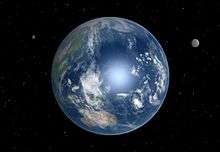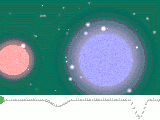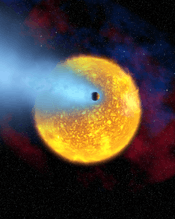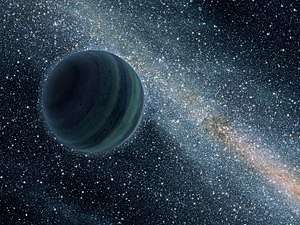Hypothetical astronomical object
A hypothetical astronomical object is an astronomical object (such as a star, planet or moon) that is believed or speculated to exist or to have existed but whose existence has not been scientifically proven. Such objects have been hypothesized throughout recorded history. For example, in the 5th century BCE, the philosopher Philolaus defined a hypothetical astronomical object which he called the "Central Fire", around which he proposed other celestial bodies (including the Sun) moved.[1]

Artist's concept of Earth, orbited by a hypothetical second moon.

31 Crateris, a possible eclipsing binary initially mistaken for a moon of Mercury.
Artist's concept of a carbon planet. The surface is dark and reddish from hydrocarbon deposits.

Artist's conception of HD 209458 b, a hypothetical Chthonian planet, transiting its star.

Artist's conception of a Jupiter-size rogue planet.
Types of hypothetical astronomical objects
Hypothetical astronomical objects have been speculated to exist both inside and outside of the Solar System, and speculation has included different kinds of stars, planets, and other astronomical objects.
- For hypothetical astronomical objects in the Solar System, see: List of hypothetical Solar System objects
- For hypothetical stars, see Hypothetical star
- For hypothetical brown dwarfs, see: List of brown dwarfs
- For hypothetical black holes, see: Hypothetical black hole
- For extrasolar moons, all of which are currently hypothetical, see: Extrasolar moon
- For stars, planets or moons whose existence is not accepted by science see: Planetary objects proposed in religion, astrology, ufology and pseudoscience and Stars proposed in religion
- For hypothetical planets in fiction see: Fictional planets of the Solar System
Hypothetical planet types
Hypothetical types of extrasolar planet include:
- Carbon planet: a terrestrial planet composed primarily of carbon, rather than silicon
- Chthonian planet: A hot Jupiter whose outer layers have been completely stripped off by its parent star
- Coreless planet: A terrestrial planet that has no metallic core
- Helium planet: a gas giant planet formed around a white dwarf star that is composed mainly of helium instead of hydrogen
- Iron planet, a planet like Mercury that consists mainly of an iron core with little mantle
- Ocean planet: A planet whose surface is covered entirely by deep oceans
- Ploonet: A planet that was originally a moon but has become gravitationally detached. Similarly, Pluto was once thought to be an escaped satellite of Neptune.
- Trojan planet: A planet that orbits with a star instead of around it
gollark: It's Emergency Backup Esobot.
gollark: According to neuroscientists, it was a moth.
gollark: Illegal drugs?
gollark: I know, I just wanted to check this myself.
gollark: ddg! buy illegal drugs
References
- Marco Ceccarelli, Distinguished Figures in Mechanism and Machine Science (2007), p. 124.
This article is issued from Wikipedia. The text is licensed under Creative Commons - Attribution - Sharealike. Additional terms may apply for the media files.